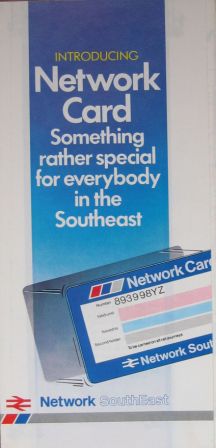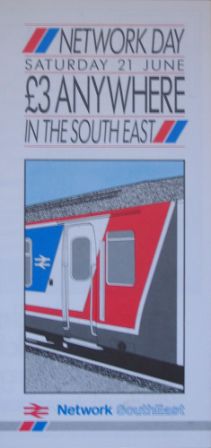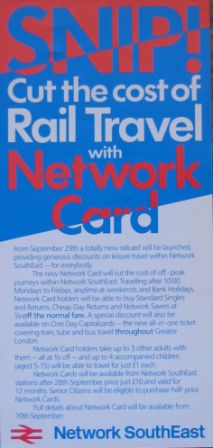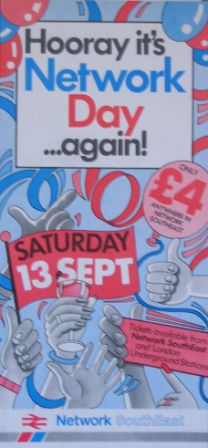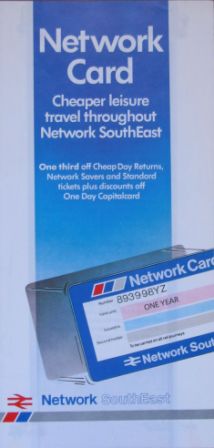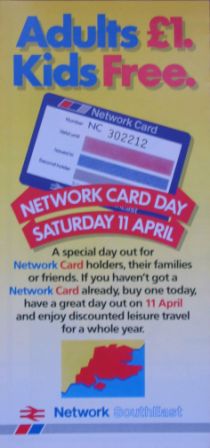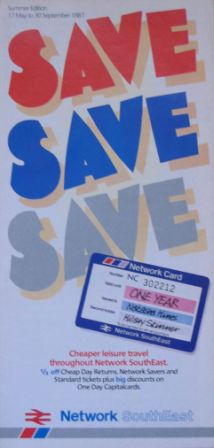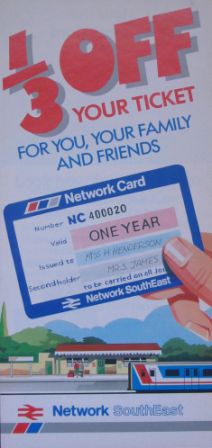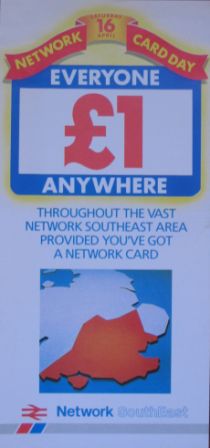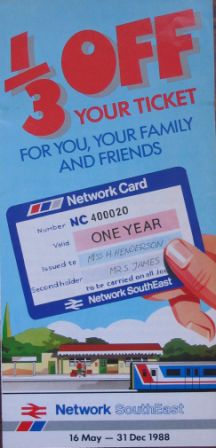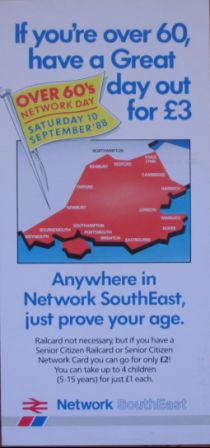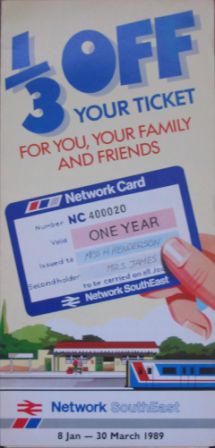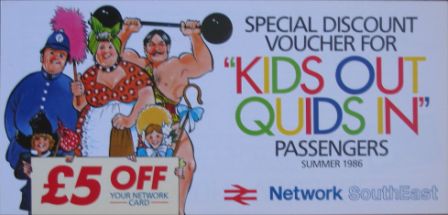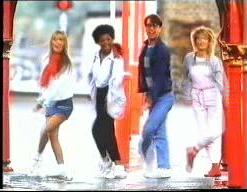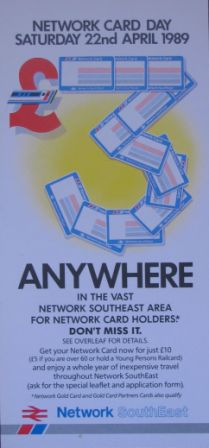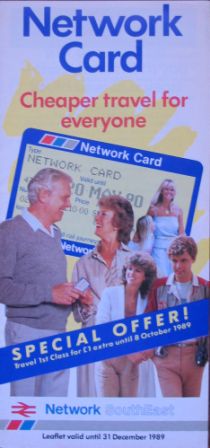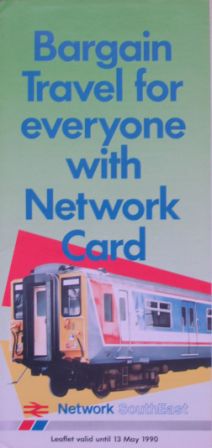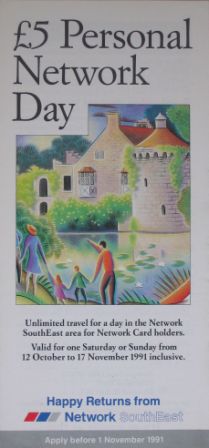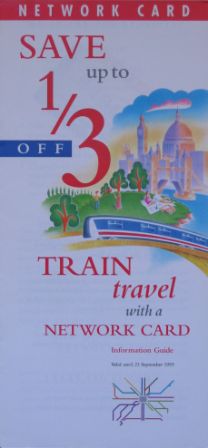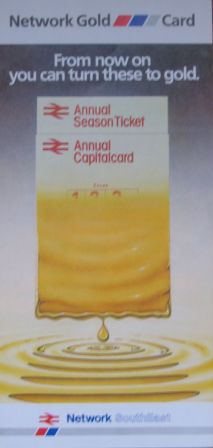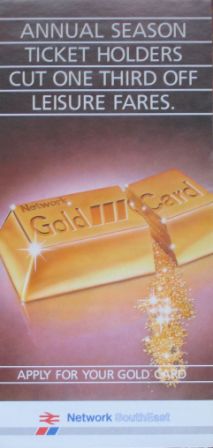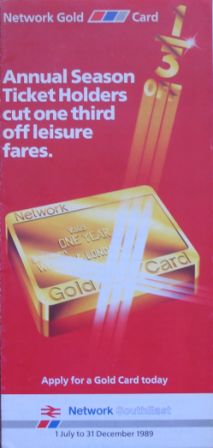Network SouthEast Publicity
Network and Gold Card
| Kids Out - Quids In | Network Card |
| The next chapter for Network Card | Gold Card |
| Return to main NSE Site |
The evolution and development of Network Card and Gold Card - filling empty seats and rewarding loyal commuters! |
Kids Out - Quids In
In 1982 British Rail‘s Director of Passenger Marketing Services devised a successful marketing promotion in the south
east called ‘Kids Out Quids In‘ to coincide with the school summer holidays. The promotion had
one simple objective, to fill some of the vast spare seating capacity on trains outside the rush hours. The proposition
was simple - ‘Buy one adult AwayDay ticket (subsequently re-branded Cheap Day Returns) and up to four others
travel for just £1 each, provided that one is a child‘. A campaign using TV, radio, press ads, station
posters and leaflets was run throughout London and the South East region, featuring Jimmy Saville and the BR corporate
advertising banner ‘This is the age of the train‘. It was primarily targeted at housewives with children.
The promotion generated considerable sales and was repeated in the summers of 1983 through until 1986, with new ads and creative work for each year. Following a change of advertising agencies the 1984/85 campaigns used the ‘We‘re getting there‘ end line, subsequently revised to Network SouthEast for 1986. |
|
Double Royal Posters
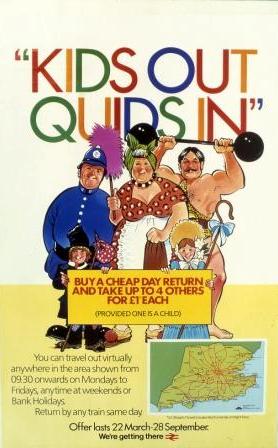 |
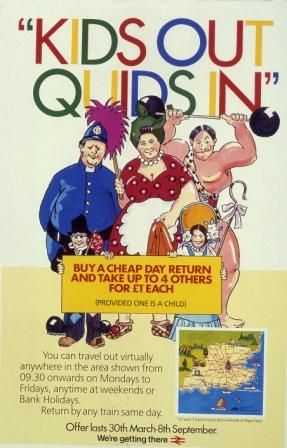 |
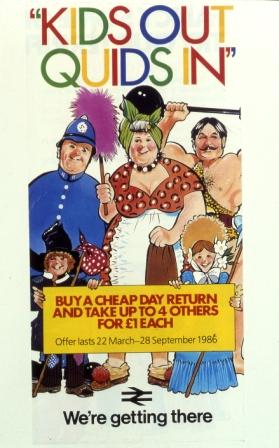 |
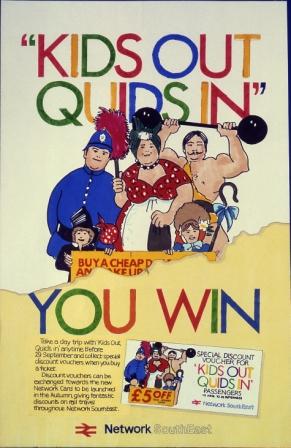 |
| March - June 1985 Original Map |
July - Sep 1985 Improved Map |
Early 1986 | 1986 £5 discount voucher |
The creation of Network SouthEast and the tough revenue targets set for it by the Department of Transport meant
that the Sector‘s marketing team needed to significantly increase income from off peak travel. ‘Kids
Out Quids In‘ had become established as being a summer time offer. A new, all year marketing initiative was
needed. Between March and July 1986, various concepts were tested through market research and focus groups. The
second most popular was the idea of a new railcard which would give discounts on the complete range of daily tickets
and allow up to four other adults or children to travel for just £1 each. The most popular concept was for
the overall reduction of all off-peak ticket prices but this was not practical. So, agreement was reached with
the BRB and the other passenger Sectors to add a new railcard to the existing range (Family Railcard, Young Persons
Railcard, Senior Citizens Railcard, etc) but to restrict its use Network SouthEast services and a few InterCity
services stopping within NSE, e.g. Paddington to Reading. And so Network Card was born.
|
Network Card
(stations and appointed travel agents):
With rail privatisation approaching, responsibility for both the Network Card and Gold Card brands was transferred to the Association of Train Operating Companies (ATOC) from 1st April 1994. |
The next chapter for Network Card
The Association of Train Operating Companies (ATOC) has always had difficulty in getting the individual Train
Operating Companies (TOCs) to support the residual railcard products and to contribute towards the marketing and
promotion of them. The TOCs don‘t feel they have ownership of or any great affinity for these remnants from
the British Rail era.
By March 2002, ownership of Network Cards had fallen to around 363,000. The price had been increased to £20, advertising and publicity was restricted to the production of a Network Card leaflet. The TOCs argued that the discounted ticket prices available to Network Card holders were abstracting revenue from their own ticket ranges. For instance some commuters were purchasing full priced single tickets for their morning peak trip into London and then using their Network Card to buy a discounted ticket for the return trip in the evening. There was also some evidence that some business travel was being delayed until after 10:00 so as to benefit from the Network Card discounts. Network Card was in danger of extinction. Fortunately, due to the lobbying by passenger groups, the writer and transport journalist Christian Woolmar, the intervention of the House of Commons Transport Select Committee, etc., sense prevailed. Network Card lives on! - please see - www.railcard.co.uk |
Gold Card
Commuting, particularly to central London, was Network SouthEast‘s primary and core business. A lot of the
improvements achieved through ‘Operation Pride‘ directly impacted on this key market consisting of
650,000 season ticket holders with 420,000 of them travelling into and out of Zone 1 every day. Around 275,000
of them were investing in and using Annual Season Tickets, representing a considerable source of ‘up
front‘ revenue for the Sector. It was important to communicate the Sector‘s plans and commitments
to this key group. The marketing objectives were:
The final solution was to re-brand Annual Season Tickets and Annual Capitalcards as Gold Cards and print them on special Gold Card ticket stock. Gold Cards were launched on 24th June 1987. The Gold Card Season Ticket became both the season ticket and a Network Card, offering exactly the same discounts on off peak leisure travel. Holders could also apply for a second, free Network Card for a partner or friend. At the same time the centralised database of Gold Card customers was established. The first in a series of Network Gold Card News (letters) were sent out in September 1986 with new editions being mailed to customers every three months over the following years. This was obviously an attractive media for third parties, the opportunity to communicate directly with a highly influential and affluent market with the south east. A series of third party promotions were included in the mailings including holiday offers, insurance, reduced price theatre tickets (the Barbican Centre) and Mercury Phonecards with free £1 credits. NSE Marketing carefully selected these promotions and derived some useful secondary income from their inclusion in the mailings. The next stage was to set up a sales fulfilment centre that could handle both renewal reminders to Gold Card holders and offer a convenient ‘next ticket by post‘ facility. Various specialist direct marketing companies were approached but in the end it was decided to bring the entire operation ‘in house‘. InterCity agreed to establish a Gold Card Centre within Euston Travel Centre, staffed by experienced ticket sellers, etc. The whole operation at Euston was set up and was running within two months. Gold Card customers were mailed a renewal reminder three to four weeks before their old ticket expired. This sophisticated mailing showed not only the new rate for the next ticket annual ticket but also showed alternative routings and prices, where these were available. For instance, customers who had previously held a ‘point to point‘ season ticket between their local station and ‘London‘ were also given the alternative Annual Capitalcard Season Ticket price. Customers could renew their tickets by completing and returning the application form and payment details. New tickets were sent out by Registered Mail. |
|
The Gold Card postal renewal service was launched on Friday 1st July 1988.
At its peak the Gold Card Direct Sales postal service was handling over 25,000 season ticket renewals per year ( around 9% of the total market). But this was lower than expected. The main deterrent was the delivery of valuable Annual Gold Cards and Capitalcards by Registered Mail. By definition most commuters were not at home to sign for receipt when the ticket arrived, they were at work. That often meant that a Saturday visit to the local sorting office was necessary, it was easier to do it all at the local station! This fundamental problem would not be overcome for some years and would rely on new technology. London Underground‘s (subsequently Transport for London‘s) Prestige Project introduced smartcards and ‘intelligent‘ ticket gates at (Underground) stations. By 2004 Oyster Cards loaded with Travelcard Season Tickets, etc could be automatically ‘renewed‘ simply by presenting the smartcard to the reader on the gates at a station nominated by the customer. For details please see the Transport for London website. As with Network Card, Gold Card lives on and is still the ‘brand‘ used by the Train Operating Companies and Transport for London for Annual Travelcards, etc. South West Trains, etc have re-christened it ‘Gold Service‘ but the principles remain much the same. For details please see the South West Trains website. |
